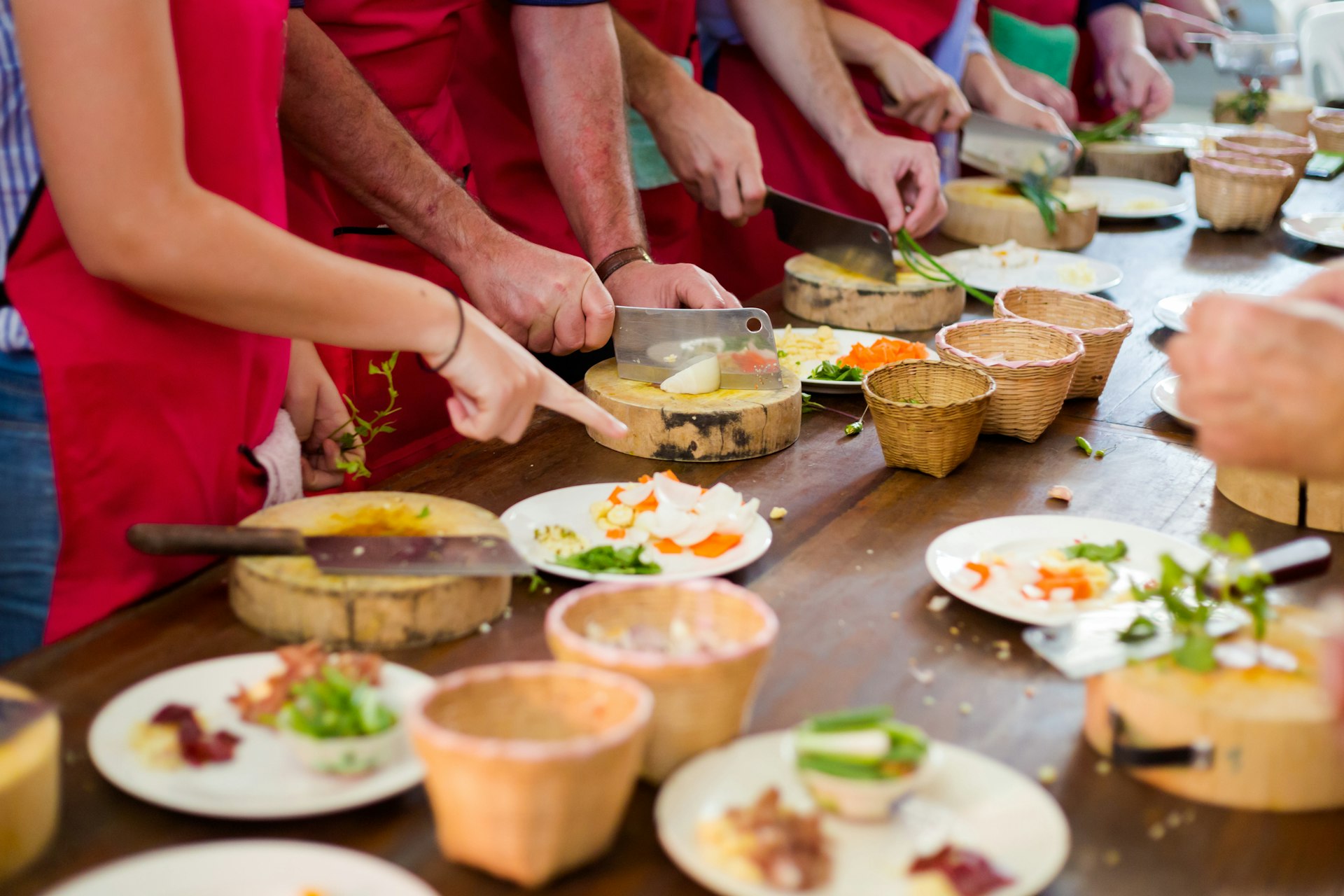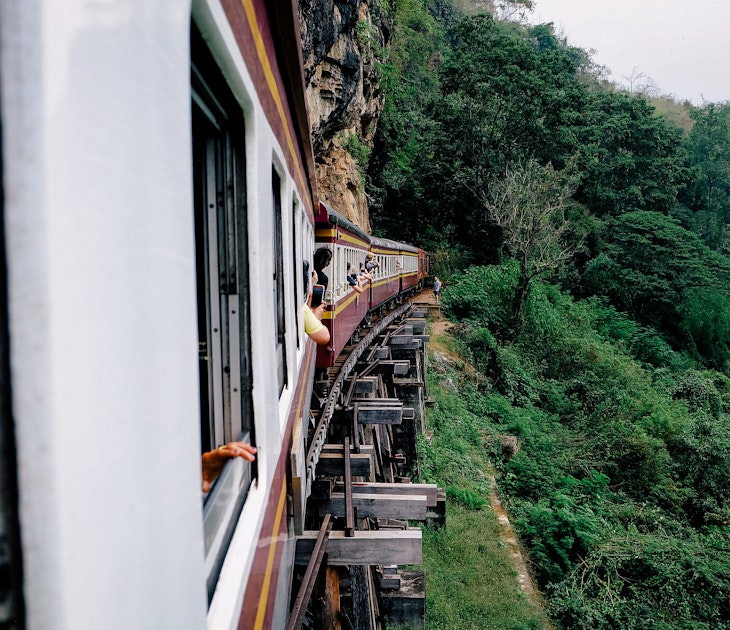Southeast Asia’s most popular holiday destination, Thailand continues to dazzle travelers with its glittering temples, tropical beaches, and mouth-watering food.
Add blockbuster natural scenery, vibrant villages, a cosmopolitan capital and buckets of culture, and it’s easy to see how the Land of Smiles has turned many a first-timer into a repeat visitor. From the best island-hopping experiences to having safe and sustainable wildlife encounters, here are the top things to do in Thailand.
Choose 3, 4, 5, 6 or 7 top Bangkok attractions and save up to 50% with Go City. Experience the city at King Power Mahanakhon Skywalk, tour Damnoen Saduak floating market, or enjoy a delicious meal on a dinner cruise - the choice is yours!
1. Tour the best of Bangkok
Between its golden temples, buzzy markets and famous culinary scene alone, there’s plenty to love about Bangkok. While you could tailor an entire trip to touring the city’s glitzy rooftop bars, take time to seek out the fascinating museums, hidden khlong (canals), and underground arts scene. From thought-provoking street art to the best meal you’ve ever had, there’s a memorable attraction around every corner in this iconic city.
Planning tip: Thanks to the Thai capital’s elevated Skytrain, it’s easy to zip between attractions without losing your bearings.
2. Explore the ruins of ancient cities
An easy day trip from Bangkok, the ruins of Ayuthaya – the former capital of the Kingdom of Siam – offer a glimpse into its glorious past. Perched atop an extinct volcano in the nation’s central north, the 13th-century ruins of Sukhothai, Thailand’s most impressive and significant Khmer historical site, is another must-see.
Planning tip: Hire a bike to explore the sites beyond the main complex of Ayuthaya Historical Park, like the smaller ruins in the green expanse of Somdet Phra Sri Nakharin Park in the southwest of the island.
3. Go island-hopping, diving and snorkeling
With more than 1400 Thai islands to choose from, where’s a traveler to begin? Home to the popular holiday idyls of Ko Lanta and the Phi Phi islands, to more off-the-beaten track tropical escapes such as the Trang archipelago and the scuba paradise of the Similan Islands, the Andaman coast is a good place to start.
Planning tip: If you’re visiting Thailand during the Andaman region’s rainy season from May to September, simply head to Gulf islands such as Ko Tao, Ko Samui, and the famed party island of Ko Pha-Ngan, where weather conditions are ideal from around February to September.
4. Join the backpacker scene in Pai
In search of Thailand’s ultimate backpacker scene? These days, many travelers will tell you it lies at the end of an ultra-scenic, winding bus ride from Chiang Mai into the lush mountains of Mae Hong Son Province. Set in a picturesque valley and surrounded by hot springs and waterfalls, Pai draws backpackers as much for its nature adventures as for its laid-back vibe, cool cafes, and late-night parties.
Planning tip: There are yoga retreats and Thai massage courses to book onto around Pai: more reasons to stay for longer.

5. Eat out or go to cooking school in Chiang Mai
The cultural capital of the north, Chiang Mai is packed with temples, and enjoys a fantastic dining scene where you can sample northern Thai specialties like the fragrant curry dish known as kôw soy (or khao soi), or learn how to make them yourself at local cooking schools.
As well as being a popular hub for digital nomads, Chiang Mai’s scenic countryside is dotted with traditional handicraft outlets, elephant sanctuaries, jungle hiking opportunities, minority villages, and more.
6. Visit the ethnically diverse hills of Chiang Rai
Sharing its border with Myanmar to the west and Laos to the east, Chiang Rai is one of Thailand’s most ethnically diverse provinces. The nation’s northernmost corner is also arguably its most beautiful. Admire Chiang Rai’s dramatic mountains, seek out its serene temples, visit its hill tribe villages responsibly, and stay a while in the atmospheric villages, some of which hug the mighty Mekong River.
Planning tip: Nearly every guesthouse, hotel and travel agency in Chiang Rai offers hiking excursions in hill country, some of which have a grassroots, sustainable or nonprofit emphasis. Everything from accommodation to transport and food is normally included in the price.

7. Hike the trails or chill by the lake in Khao Sok National Park
If you only have time to visit one of Thailand’s spectacular national parks, make it Khao Sok. This ancient rainforest hugging the midsection of southern Thailand is laced with sweaty hiking trails that reward you with postcard-perfect views of limestone formations fringing the emerald waters of Chiaw Lan Lake. You can also go tubing, kayaking and rafting, and sleep in a floating hut.
8. Soak up the romance of Railay
Soaring limestone karsts rise up behind sugar-white beaches lapped by turquoise water in Railay, easily one of Thailand’s most genetically blessed seaside destinations. Come to lounge on beautiful beaches, explore scenic caves, and test your rock-climbing skills. Home to a number of resorts, Railay is also a popular romantic escape for couples.
Local tip: There are none of Thailand’s typical traffic hassles here because visitors come and go by longtail boat.

9. Have an authentic homestay experience with a local family
Craving an authentic cultural experience? Offering an opportunity to connect with Thai people on a deeper and more authentic level than the average village tour, community-based ecotourism (CBET) is a great place to start.
Hosted across the country, from the mountain towns of Chiang Mai Province to the Muslim fishing villages of Phang-Nga Province, CBET experiences usually take the form of a homestay combined with eco-conscious activities ranging from cooking classes to mangrove planting.
10. Choose your own adventure in Kanchanaburi
The provincial capital’s WWII memorials are a mandatory stop before heading deeper into the spectacular wilderness areas of Kanchanaburi Province, where rivers ooze between jagged limestone peaks rising out of the verdant jungle. From kayaking to jungle treks, there are plenty of activities to choose from in this popular adventure center.
Local tip: Having your own transport is convenient, but not totally necessary. Most of the main attractions here, including Erawan National Park and the Hellfire Pass Interpretive Centre, can be reached by public transport.

11. Book a traditional Thai massage
Have you even been to Thailand if you haven’t had a traditional Thai massage? Combining acupressure, Ayurvedic principles and assisted yoga postures, this quintessentially Thai style of massage has been linked to health benefits ranging from boosting energy to busting stress. Costing as little as 250 baht (US$7.50) for a one-hour massage at a simple salon, they’re also great value.
Local tip: You can support local enterprises by visiting places that provide employment opportunities for vulnerable locals, such as blind therapists.
12. Venture beyond the resorts of Phuket
Home to some of Thailand’s best resorts – at every budget – the Andaman holiday haven of Phuket is also blessed with some of Thailand’s loveliest beaches. But there’s plenty more to discover beyond your sun lounger.
Less than 30 minutes’ drive west from the hedonistic hub of Patong, Phuket Town’s colorful heritage buildings house excellent restaurants, boutiques and museums. And in the island’s northeast, you can visit a wildlife sanctuary working to rehabilitate gibbons rescued from the pet trade, and take a refreshing dip in a waterfall nearby.
13. Embrace responsible elephant tourism
Asian elephants have played an important role in Thai culture for centuries, and in good news for Thailand’s elephants, and visitors who come to see them, many of Thailand’s elephant attractions have acted on global calls to cease offering activities that are harmful for elephants and dangerous for tourists.
A small but growing number of operators including ChangChill near Chiang Mai and Following Giants in Ko Lanta have even transitioned to observation-only experiences, where elephants can be admired doing what they do best: simply being elephants.
Planning tip: You might also be lucky enough to spot wild elephants in Khao Yai National Park, just a few hours from Bangkok.














